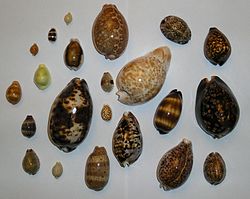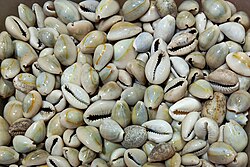Cowry
Cowry shells (or cowrie), are marine snails of the family Cypraeidae.
| Cowry | |
|---|---|

| |
| Cypraea caputserpentis L., 1758; very common in intertidal rocky areas. | |
| Scientific classification | |
| Kingdom: | |
| Phylum: | |
| Class: | |
| Subclass: | |
| Order: | |
| Superfamily: | |
| Family: | Cypraeidae
|

They are found chiefly in tropical regions. There are about 200 different species of cowry.
Shell
The shell itself is almost always very smooth and shiny.[1] They have with a long, narrow, slit-like opening. All varieties have a porcelain-like shine and many have colorful patterns. In life the shell is covered by the slippery mantle.
Shell sizes range from 5 mm (1/5") for some tropical species to 15 cm (6") for the tiger cowry, Cypraea tigris.
Predators
The slippery shell is very difficult for most animals to grip. The very narrow toothed aperture of the cowry shell makes it difficult for predators to reach into. However cowries are still vulnerable to predation:
- Some tropical crustaceans can break the dorsum of a cowry shell.
- Some mollusc-eating cones like Conus textile can inject venom into the cowry's flesh. The cone then extends its stomach into the shell, through the slit, to completely ingest the flesh.
- Some octopuses can gouge a small hole (using a special barb/tooth and an acidic secretion) through the shell to inject a venom that kills the animal within.
Taxonomy
For nearly 200 years, every species in the family Cypraeidae was placed in one genus, Cypraea, but in 2002 [2] the cowries were divided into many different genera.[3]
Uses
Cowries (esp. Cypraea moneta) were used as a currency in Africa (Ghanaian cedi in Ghana named after cowry shells) and elsewhere, such as in China where the shell or copies of the shell were in theory used as a means of exchange. They are also worn as jewelry or otherwise used as ornaments or charms, as they are viewed as symbols of womanhood, fertility, birth and wealth. Many find the shiny, porcelain-like shells pleasing to look at.
Cowry shells are sometimes used in a way similar to dice, e.g., in board games like Pachisi, or in divination (cf. Ifá and the annual customs of Dahomey). A number of shells (6 or 7 in Pachisi) are thrown, with those landing aperture upwards indicating the actual number rolled.
Cowries have also been used in the recent past as a frame over which sock heels were stretched for darning. The cowry ridges allowed the needle to get under the cloth more easily.
The Ojibway aboriginal people in North America used the cowry shells in ceremonies, and the Whiteshell Provincial Park in Manitoba, Canada is named after this type of shell. There is some debate about how they traded for or found these shells so far inland, away from the natural sources. Oral stories and birch bark scrolls seem to indicate that they were found in the ground, and/or washed up on the shores of lakes or rivers. The cowry shells so far inland may indicate the use of them by an earlier tribe or group in the area, and an extensive trade network in the ancient past.
The typewritten postage stamps of 1895 Uganda also are called "Cowries".
Cowry Media
1742 drawing of shells of the money cowrie, Monetaria moneta
Traditional Chuvash necklace made from silver coins, cowrie shells, and beads
References
- ↑ A few species have granular shells.
- ↑ Lorenz F. 2002. New Worldwide Cowries. Descriptions of new taxa and revisions of selected groups of living Cypraeidae (Mollusca: Gastropoda). Schriften zur Malakozoologie aus dem Haus der Natur-Cismar 20: 1-292, plates 1-40
- ↑ Bouchet P. et al. 2005. Classification and nomenclator of gastropod families. Malacologia: International Journal of Malacology. 47 (1-2): 1–397. ISBN 3925919724 ISSN 0076-2997
Other websites
| Wikimedia Commons has media related to Lua error in Module:Commons_link at line 62: attempt to index field 'wikibase' (a nil value).. |
- cowrys.org Archived 2006-02-02 at the Wayback Machine
- Cowrie Genomic Database Project Archived 2009-04-14 at the Wayback Machine
- Genus Cypraea on Animal Diversity Web Archived 2006-05-27 at the Wayback Machine
- Cowries.info




